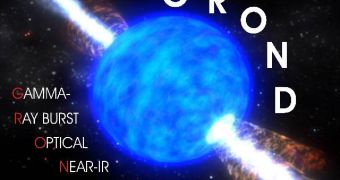A new instrument went online at the ESO Telescope at the La Silla Observatory and was able to take images simultaneously in seven colors, to examine the most energetic phenomena in the universe, the gamma-ray bursts.
From time to time, a huge explosion followed by a bright flash of light can be observed in space. It's a colossal gamma-ray burst (GRB), emitting for a few seconds as much radiation as a million galaxies.
They are truly impressive space phenomena, as even the smallest GRB can emit the same amount of energy our Sun will emit over its expected 10 billion-year lifetime, in just one second.
The most luminous events known in the universe since the Big Bang are flashes of gamma rays, coming from seemingly random places in the sky and at random times, that last from milliseconds to many minutes and are often followed by "afterglow" emission at longer wavelengths (X-ray, UV, optical, IR and radio).
GROND will study these energy discharges, invisible to our eyes, to determine how far in space they occur. It will be able to take images in different filters simultaneously, a vital ability for studying many astronomical sources.
"To make the determination of distance of far-away objects as accurate as possible, we decided to use four different filters in the optical and three different filters in the near-infrared," says Jochen Greiner, who led the development of the GROND instrument. GROND stands for Gamma-Ray burst Optical/Near-Infrared Detector.
Taking images of various regions of the sky in seven different filters, the instrument will detect these events and calculate astronomical distance with impressive accuracy. In a previous demonstration, GROND observed a quasar located more than 12 billion light-years away.
Studying these high-energy objects and events could provide scientists with a totally new understanding of our Universe and reveal things no astronomer has ever seen before, using the existent gamma-ray satellites.

 14 DAY TRIAL //
14 DAY TRIAL //